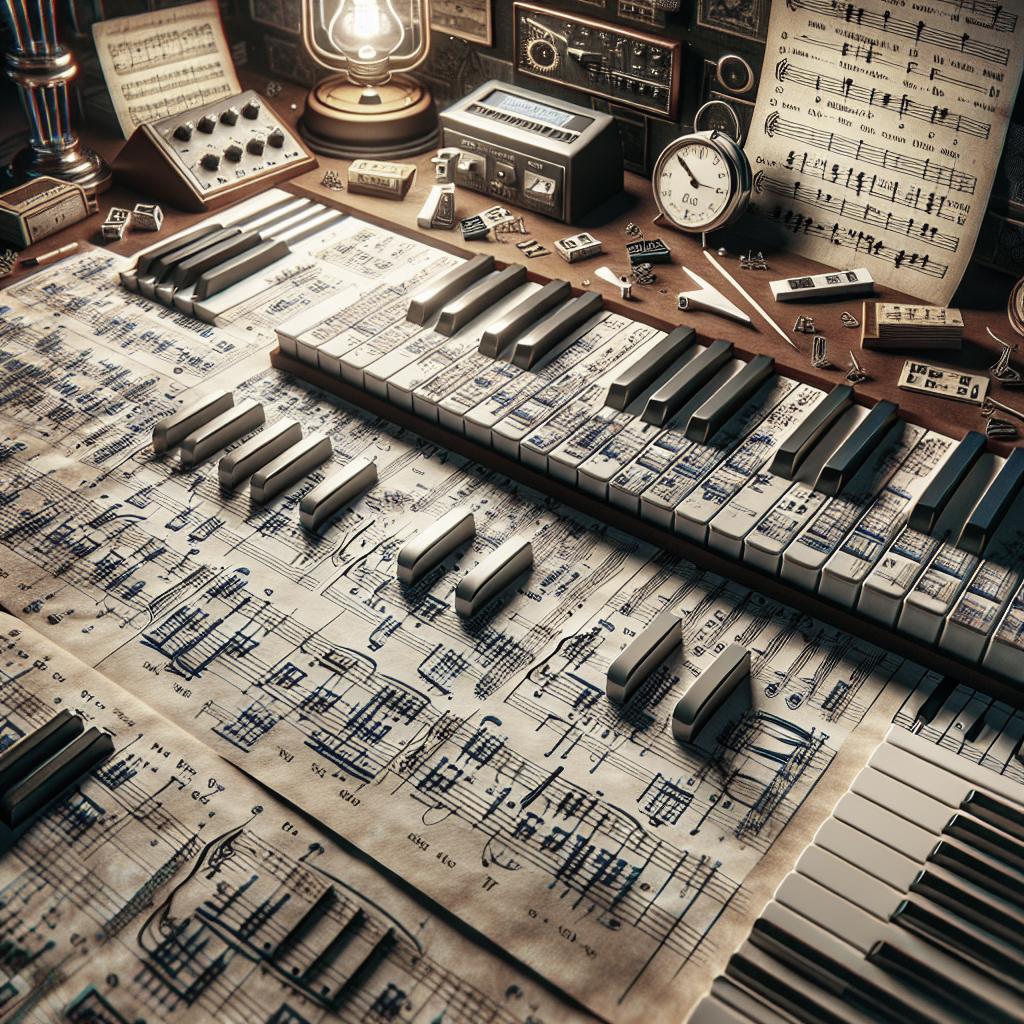“`html
Chord Progressions Explained
Music, with its magical ability to evoke emotions and tell stories, relies heavily on chord progressions to create its harmonic foundation. Whether you’re a novice musician or an experienced composer, understanding these progressions can enhance your creative palette. This article explores the fundamentals of chord progressions by analyzing various common patterns. From the basic single chord to more complex progressions, these structures serve as the backbone of countless songs. By delving into the theory and application of progressions like I-IV-V and their extensions, you’ll discover the essence of creating compelling music. Let’s embark on a melodious journey to unveil the mysteries of chords.
Black Friday Music Deal Tracker: The Best Gear Deals in 2024
Before diving into the heart of chord progressions, I’d like to take a moment to mention an exciting opportunity for all music enthusiasts. The Black Friday music deal tracker of 2024 will be your guide to securing the best gear deals of the year. Whether you’re in need of a new guitar, keyboard, or audio interface, these deals provide a chance to upgrade your musical toolbox without breaking the bank.
Stay ahead of the curve by subscribing to newsletters from your favorite music stores and keep an eye on the deal tracker. These exclusive offers often sell out quickly, so it’s best to plan ahead and act fast when you spot a deal that suits your needs. With these savings, investing in quality instruments and equipment becomes more accessible, enabling you to expand your creative exploration.
Submit a Comment Cancel reply
Your input is invaluable in enriching this discussion on chord progressions. Feel free to share your thoughts or ask questions in the comment section below. Engaging with fellow musicians and enthusiasts can lead to insightful exchanges and new ideas. Remember, music is a collective experience, and by contributing, you can enhance both your understanding and that of others.
Chords by number
Chords are often represented by Roman numerals to denote their position within a scale. This system helps musicians easily communicate and understand the harmonic structure of a piece regardless of the key. Each numeral corresponds to a degree in the scale with “I” representing the tonic, the home base from which progressions commonly start.
Understanding chords by their numerical representation allows for a versatile approach to composing. Whether shifting from one key to another or improvising, knowing the numbers grants a level of fluidity. The intuitive nature of numeral chords enables musicians to envision connections between different scales and effortlessly transpose music into various contexts.
Just the I
At the heart of any scale, the “I” chord, or tonic, anchors the music with a sense of resolution and completeness. Though simply sticking to the tonic may seem rudimentary, many genres exploit this stability as a deliberate artistic choice. The “I” can emphasize a melody or lyrics, creating an atmosphere of tranquility or conclusion.
Beyond its soothing nature, the tonic serves as a solid base from which other chords evolve. By focusing on the “I,” musicians learn to appreciate its foundational role, encouraging experimentation with subtle variations like added notes or rhythmic alterations. This practice can lend a new perspective to minimalist compositions or storytelling through music.
I and V
Introducing the “V,” or dominant chord, injects tension and drive into a piece. This chord naturally desires to resolve back to the tonic, creating a compelling push and pull relationship fundamental to Western music. The I-V progression is one of the simplest yet most effective in establishing harmonic movement.
The interplay between these two chords often gives rise to captivating melodies and underscores dramatic storytelling. Composers frequently use it in various musical contexts, from lullabies to symphonies. As one explores the depths of these interactions, the nuanced balance of anticipation and satisfaction becomes a powerful tool for emotive composition.
I and IV
The addition of the “IV,” or subdominant chord, creates a new layer of harmonic complexity. This chord serves as a gentle detour before returning to the tonic, adding diversity and texture to musical narratives. The I-IV progression can evoke pastoral imagery or convey a sense of journeying or longing.
In the realm of pop and folk music, this combination resonates with heartfelt simplicity. It is a favorite for many songwriters due to its ability to convey sincerity and warmth. By mastering the intricacies of the I-IV transition, musicians can offer listeners a seamless blend of familiarity and innovation.
I, IV, V
A staple progression in Western music, the I-IV-V forms the basis of countless iconic tunes. Its versatility is unmatched, seamlessly fitting genres from blues to rock and classical compositions. This trio of chords sets up an expectation of resolution, creating dynamic movement within a piece.
For beginners, the I-IV-V progression serves as a gateway to songwriting, allowing for immersive exploration of chord transitions. More advanced musicians can experiment with rhythms, inversions, and more complex variations, crafting unique interpretations. This progression invites creators to build upon a timeless framework, adding personal flair to age-old harmonies.
Take vi
Incorporating the “vi” chord, known as the submediant, adds a rich layer of emotion to compositions. Often perceived as the relative minor, the vi introduces a somber or reflective quality, bridging major sounds with a tinge of melancholy. Progressions like I-vi-IV-V have found immense popularity across genres for their emotional resonance.
Musicians use the vi to convey depth and introspection, accentuating narrative elements in their work. Its ability to seamlessly integrate into various progressions enhances its appeal to composers seeking to add a poignant touch. The balance of major and minor elements achieved through the vi chord continues to inspire evocative storytelling through song.
The ii and iii
The “ii” and “iii” chords introduce subtle complexity within a scale. The ii, or supertonic, often serves as a prelude to the dominant, enhancing progressions with an air of anticipation. Meanwhile, the iii chord, the mediant, adds an unexpected twist when interwoven within a sequence, offering fresh tonal perspectives.
These chords expand the palette of harmonic options available to musicians, fostering adventurous arrangements. They are instrumental in jazz and classical music for their ability to facilitate smooth modulations and unexpected turns. Embracing the ii and iii allows composers to craft intricate tapestries of sound that surprise and delight audiences.
The vii°
The “vii°,” or leading tone diminished chord, is a catalyst of tension in musical storytelling. Its inherent instability demands a resolution, typically drawing back to the tonic. This magnetic pull makes it a key player in creating drama and suspense within a composition.
Utilizing the vii° strategically evokes anticipation and release, often resulting in a cathartic musical experience. Musicians can explore its potential for drama by employing it in cadences and modulations. Even a brief encounter with this chord can profoundly alter the listener’s emotional journey, underscoring climactic moments in a piece.
Dig deeper.
As you delve into the world of chord progressions, you’ll begin to recognize their fluid nature. Exploring less common chords and experimenting with different combinations can unveil new horizons in your music. Let curiosity drive your journey, test creative boundaries, and develop a unique harmonic voice.
From questioning traditional progressions to incorporating global influences, the possibilities are boundless. By cultivating an understanding of these structures, you gain the freedom to innovate while respecting musical tradition. In this endless exploration, you embrace the joy of crafting soundscapes that resonate with both you and your audience.
Summary of Main Points
| Chord | Description |
|---|---|
| I | Tonic, represents resolution and stability. |
| V | Dominant, creates tension and seeks resolution. |
| IV | Subdominant, provides contrast and movement. |
| vi | Submediant, adds depth and emotional reflection. |
| ii and iii | Adds anticipation and tonal variety. |
| vii° | Leading tone, heightens tension and drama. |
“`


